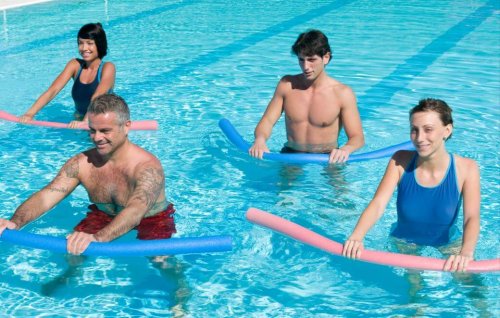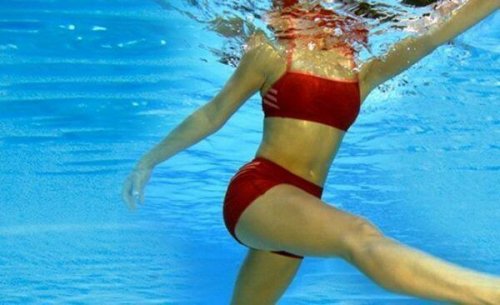Water Gym: Discover Water Gymnastics

Swimming isn’t the only way to condition your body in an aquatic environment. The water offers us a very useful resistance force for training. Under this premise, water gym was born.
If you think that it’s a matter of using a pool as your training center, you’re correct. Although putting a bicycle in the pool might sound crazy, nowadays it’s possible.
What is a water gym?
The water gym is simply performing gymnastic exercises in a space that’s full of water. In fact, this practice uses many of the movements that we would normally do while training in the gym, except they’re performed in a submerged container.
Of course, there are some differences in contrast to traditional exercises. The first is that joints and muscles suffer less impact since they’re covered by water. The routines are usually shorter due to the effort, however, that doesn’t mean they’re not effective.
Additionally, the dynamics allow us to enjoy the exercise and regard it as something fun. This way, we can guide people with difficulties to concentrate on performing demanding physical activities.
Elements and accessories for water gymnastics
There are many types of exercises we can perform in the water. These are some of the best known:
- Same as in the gyms: in this practice, we’ll use implements to exercise various body parts. For instance, there are countercurrent devices with which we increase the resistance strength of water.
- There’s also the water bicycle: when using it, we have to fight against the weight of the water. Pedaling on land is usually really demanding, but the degree of difficulty rises when we do it this way.
- Using rubber foam pieces: the purpose is to work in various positions and grips, depending on the muscles. The accessories don’t necessarily have to be weighted because the water generates resistance. On the other hand, we can also use weights in the pool.

A general guideline for water routines
If you usually go to the gym to train for an hour or more, you should know that this will be quite different in the water. Generally, the first challenge for people is to do a session of at least ten minutes. As we’ve mentioned, working out in a water gym is often demanding and exhausting.
An ideal estimated time would be to train for around 150 minutes per week under this discipline. Athletes with lots of experience complete sessions of up to 50 minutes. In these cases, a whole day of rest is left between workouts.
You can also perform a daily routine of up to 20 minutes. This is what intermediate level practitioners do. This trend is, of course, evolving: nowadays, there are several types of aquatic training, including aquatic CrossFit.
The advantages of water gymnastics
People with physical problems in rehabilitation can feel more comfortable exercising in the water. It’s even much easier for an obese person to get into shape this way. The best thing is that the exercises have the same intensity and are even more demanding than in a traditional gym.
One of the reasons is that physical activity is taking place in a comfortable and fresh environment. Moreover, people usually make great efforts but in a way it that seems like a game. Water training is usually much more fun than anaerobic routines on land.
The rest is incorporating normal exercises and doing them in the water. We can do sit-ups, squats, and work small muscles. There are also people who combine it with a few minutes of swimming to strengthen their torso.

Additional benefits of a water gym
Although the main purpose of the water gym is the possibility of working out many muscles simultaneously, its benefits go beyond exercise. For example, this type of activity is similar to a massage that drains the skin. Besides the degree of difficulty, some find it relaxing.
Ultimately, the water gym helps improve blood circulation throughout the body. This is achieved through a traditional exercise to a much more limited extent. According to the characteristics of each athlete, anybody can do this type of physical work regardless of their age.
Swimming isn’t the only way to condition your body in an aquatic environment. The water offers us a very useful resistance force for training. Under this premise, water gym was born.
If you think that it’s a matter of using a pool as your training center, you’re correct. Although putting a bicycle in the pool might sound crazy, nowadays it’s possible.
What is a water gym?
The water gym is simply performing gymnastic exercises in a space that’s full of water. In fact, this practice uses many of the movements that we would normally do while training in the gym, except they’re performed in a submerged container.
Of course, there are some differences in contrast to traditional exercises. The first is that joints and muscles suffer less impact since they’re covered by water. The routines are usually shorter due to the effort, however, that doesn’t mean they’re not effective.
Additionally, the dynamics allow us to enjoy the exercise and regard it as something fun. This way, we can guide people with difficulties to concentrate on performing demanding physical activities.
Elements and accessories for water gymnastics
There are many types of exercises we can perform in the water. These are some of the best known:
- Same as in the gyms: in this practice, we’ll use implements to exercise various body parts. For instance, there are countercurrent devices with which we increase the resistance strength of water.
- There’s also the water bicycle: when using it, we have to fight against the weight of the water. Pedaling on land is usually really demanding, but the degree of difficulty rises when we do it this way.
- Using rubber foam pieces: the purpose is to work in various positions and grips, depending on the muscles. The accessories don’t necessarily have to be weighted because the water generates resistance. On the other hand, we can also use weights in the pool.

A general guideline for water routines
If you usually go to the gym to train for an hour or more, you should know that this will be quite different in the water. Generally, the first challenge for people is to do a session of at least ten minutes. As we’ve mentioned, working out in a water gym is often demanding and exhausting.
An ideal estimated time would be to train for around 150 minutes per week under this discipline. Athletes with lots of experience complete sessions of up to 50 minutes. In these cases, a whole day of rest is left between workouts.
You can also perform a daily routine of up to 20 minutes. This is what intermediate level practitioners do. This trend is, of course, evolving: nowadays, there are several types of aquatic training, including aquatic CrossFit.
The advantages of water gymnastics
People with physical problems in rehabilitation can feel more comfortable exercising in the water. It’s even much easier for an obese person to get into shape this way. The best thing is that the exercises have the same intensity and are even more demanding than in a traditional gym.
One of the reasons is that physical activity is taking place in a comfortable and fresh environment. Moreover, people usually make great efforts but in a way it that seems like a game. Water training is usually much more fun than anaerobic routines on land.
The rest is incorporating normal exercises and doing them in the water. We can do sit-ups, squats, and work small muscles. There are also people who combine it with a few minutes of swimming to strengthen their torso.

Additional benefits of a water gym
Although the main purpose of the water gym is the possibility of working out many muscles simultaneously, its benefits go beyond exercise. For example, this type of activity is similar to a massage that drains the skin. Besides the degree of difficulty, some find it relaxing.
Ultimately, the water gym helps improve blood circulation throughout the body. This is achieved through a traditional exercise to a much more limited extent. According to the characteristics of each athlete, anybody can do this type of physical work regardless of their age.
All cited sources were thoroughly reviewed by our team to ensure their quality, reliability, currency, and validity. The bibliography of this article was considered reliable and of academic or scientific accuracy.
- Chen, L. J., Fox, K. R., Ku, P. W., & Chang, Y. W. (2016). Effects of Aquatic Exercise on Sleep in Older Adults with Mild Sleep Impairment: a Randomized Controlled Trial. International Journal of Behavioral Medicine, 23(4), 501–506. https://doi.org/10.1007/s12529-015-9492-0
- José Luis Valderrama Florez. Propuesta de entrenamiento funcional de fuerza para practicantes de polo acuático. http://bibliotecadigital.univalle.edu.co/bitstream/10893/7218/1/3484-0430871.pdf
This text is provided for informational purposes only and does not replace consultation with a professional. If in doubt, consult your specialist.








